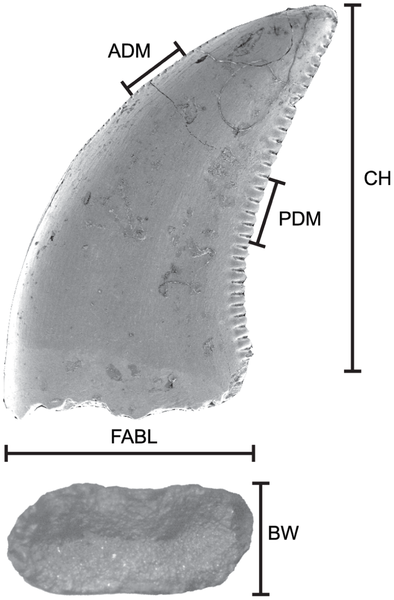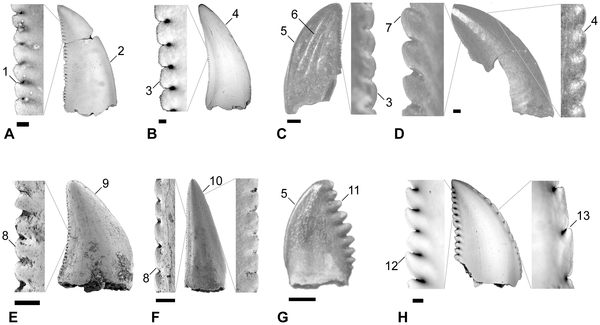Isolated small theropod teeth are abundant in vertebrate microfossil assemblages, and are frequently used in studies of species diversity in ancient ecosystems. However, determining the taxonomic affinities of these teeth is problematic due to an absence of associated diagnostic skeletal material. Species such as Dromaeosaurus albertensis, Richardoestesia gilmorei, and Saurornitholestes langstoni are known from skeletal remains that have been recovered exclusively from the Dinosaur Park Formation (Campanian). It is therefore likely that teeth from different formations widely disparate in age or geographic position are not referable to these species. Tooth taxa without any associated skeletal material, such as Paronychodon lacustris and Richardoestesia isosceles, have also been identified from multiple localities of disparate ages throughout the Late Cretaceous. To address this problem, a dataset of measurements of 1183 small theropod teeth (the most specimen-rich theropod tooth dataset ever constructed) from North America ranging in age from Santonian through Maastrichtian were analyzed using multivariate statistical methods: canonical variate analysis, pairwise discriminant function analysis, and multivariate analysis of variance. The results indicate that teeth referred to the same taxon from different formations are often quantitatively distinct. In contrast, isolated teeth found in time equivalent formations are not quantitatively distinguishable from each other. These results support the hypothesis that small theropod taxa, like other dinosaurs in the Late Cretaceous, tend to be exclusive to discrete host formations. The methods outlined have great potential for future studies of isolated teeth worldwide, and may be the most useful non-destructive technique known of extracting the most data possible from isolated and fragmentary specimens. The ability to accurately assess species diversity and turnover through time based on isolated teeth will help illuminate patterns of evolution and extinction in these groups and potentially others in greater detail than has previously been thought possible without more complete skeletal material.

Tooth measurements used in this study.
ADM, anterior denticles per millimetre; BW, basal width; CH, crown height; FABL, fore-aft basal length; and PDM, posterior denticles per millimetre.
doi:10.1371/journal.pone.0054329.g001

Qualitative morphotypes used to construct a priori categories within formations and the qualitative characters that define them.
A, Saurornitholestinae; B, Dromaeosaurinae; C, cf. Zapsalis; D, Dromaeosauridae; E, cf. Richardoestesia gilmorei; F, cf. Richardoestesia isosceles; G, cf. Pectinodon; and H, cf. Troodon. Qualitative characters: 1, posterior denticles apically oriented (that is, asymmetric denticles with a shorter apical side); 2, anterior denticles much smaller than posterior denticles; 3, posterior denticles rounded; 4, anterior denticles the same or slightly smaller than posterior denticles; 5, anterior denticles usually absent; 6, strong longitudinal ridges; 7, posterior denticles large and apically oriented; 8, posterior denticles are small and rounded; 9, anterior denticles are similar in size to posterior denticles or absent; 10, tall isosceles triangle shape; 11, posterior denticles very large and often rounded with apex of tooth frequently forming apical-most denticle; 12, posterior denticles are very large and apically hooked; and 13, anterior denticles are very large or absent. A, B, and H modified from Larson et al. 2010; C–F modified from Larson (2008); and G modified from Longrich (2008). Scale bars are 1 mm and correspond to images of crowns.
doi:10.1371/journal.pone.0054329.g002
![Summary of quantitative morphotypes showing their stratigraphic ages. show more Each tooth icon likely represents a distinct taxon with the indicated known range based on formation as observed in this study. A, Lancian Saurornitholestinae gen. et sp., UCMP 187036 (reversed); B, Pectinodon bakkeri; C, Lancian cf. Richardoestesia gilmorei, UCMP 120255 (reversed); D, Lancian cf. Richardoestesia isosceles, UCMP 187175 (reversed); E, Atrociraptor marshalli, TMP 2000.045.0035; F, Horseshoe Canyon Dromaeosaurinae gen. et sp., TMP 1999.050.0116 (reversed); G, Horseshoe Canyon cf. Troodon sp., TMP 2000.045.0024 (reversed); H, Horseshoe Canyon cf. R. gilmorei, TMP 2003.015.0002; I, Saurornitholestes langstoni, TMP 1995.147.0026; J, Bambiraptor feinbergi, AMNH FR 30556; K, Dromaeosaurus albertensis, TMP 1986.130.0211; L, Zapsalis abradens, TMP 1987.050.0008; M, Troodon formosus, TMP 1995.147.0025; N, Dinosaur Park cf. Pectinodon sp., TMP 2000.021.0001; O, Richardoestesa gilmorei, TMP 2000.019.0004; P, Oldman cf. R. gilmorei, 1987.080.0035; Q, Richardoestesia isosceles, LSUMGS 489∶6238 (reversed); R, Milk River Saurornitholestinae gen. et sp., UALVP 50531 (reversed); S, Milk River Dromaeosauridae gen. et sp., UALVP 48365 (reversed); T, Milk River Dromaeosaurinae gen. et sp., UALVP 49571; U, Milk River cf. Zapsalis sp., UALVP 49582; V, Aquilan cf. Richardoestesia gilmorei, UALVP 48157 (reversed); and W, Aquilan cf. Richardoestesia isosceles, UALVP 48279 (reversed). B modified from Longrich (2008); H modified from Larson et al. (2010); J modified from Burnham (2004); P modified from Sankey et al. (2002); Q modified from Sankey (2001); R–W modified from Larson (2008). Teeth scaled to matching FABL. [full page width]. doi:10.1371/journal.pone.0054329.g006](http://worldfossilsociety.org/wp-content/uploads/2013/12/131029133124-large11.png)
Summary of quantitative morphotypes showing their stratigraphic ages.
Each tooth icon likely represents a distinct taxon with the indicated known range based on formation as observed in this study. A, Lancian Saurornitholestinae gen. et sp., UCMP 187036 (reversed); B, Pectinodon bakkeri; C, Lancian cf. Richardoestesia gilmorei, UCMP 120255 (reversed); D, Lancian cf. Richardoestesia isosceles, UCMP 187175 (reversed); E, Atrociraptor marshalli, TMP 2000.045.0035; F, Horseshoe Canyon Dromaeosaurinae gen. et sp., TMP 1999.050.0116 (reversed); G, Horseshoe Canyon cf. Troodon sp., TMP 2000.045.0024 (reversed); H, Horseshoe Canyon cf. R. gilmorei, TMP 2003.015.0002; I, Saurornitholestes langstoni, TMP 1995.147.0026; J, Bambiraptor feinbergi, AMNH FR 30556; K, Dromaeosaurus albertensis, TMP 1986.130.0211; L, Zapsalis abradens, TMP 1987.050.0008; M, Troodon formosus, TMP 1995.147.0025; N, Dinosaur Park cf. Pectinodon sp., TMP 2000.021.0001; O, Richardoestesa gilmorei, TMP 2000.019.0004; P, Oldman cf. R. gilmorei, 1987.080.0035; Q, Richardoestesia isosceles, LSUMGS 489∶6238 (reversed); R, Milk River Saurornitholestinae gen. et sp., UALVP 50531 (reversed); S, Milk River Dromaeosauridae gen. et sp., UALVP 48365 (reversed); T, Milk River Dromaeosaurinae gen. et sp., UALVP 49571; U, Milk River cf. Zapsalis sp., UALVP 49582; V, Aquilan cf. Richardoestesia gilmorei, UALVP 48157 (reversed); and W, Aquilan cf. Richardoestesia isosceles, UALVP 48279 (reversed). B modified from Longrich (2008); H modified from Larson et al. (2010); J modified from Burnham (2004); P modified from Sankey et al. (2002); Q modified from Sankey (2001); R–W modified from Larson (2008). Teeth scaled to matching FABL. [full page width].
doi:10.1371/journal.pone.0054329.g006
Citation: Larson DW, Currie PJ (2013) Multivariate Analyses of Small Theropod Dinosaur Teeth and Implications for Paleoecological Turnover through Time. PLoS ONE 8(1): e54329. doi:10.1371/journal.pone.0054329
Editor: Alistair Robert Evans, Monash University, Australia



 December 23rd, 2013
December 23rd, 2013  Riffin
Riffin  Posted in
Posted in  Tags:
Tags: 